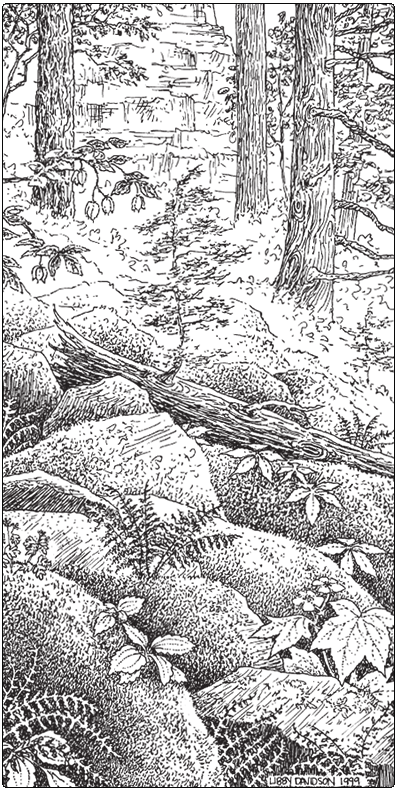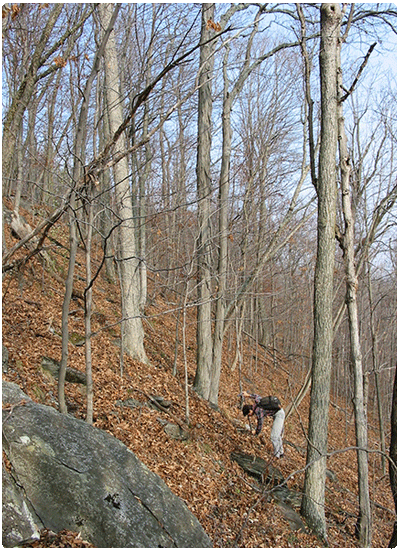Ecology and Physical Setting
In the agricultural landscape of lowland Vermont, these places are wild havens of jumbled rocks, dense shrubs, rare ferns, odd trees, and fascinating wildlife. Although they tend to be small (less than 10 acres in most cases) and are often near agricultural areas, they can seem very far away from the cultivated landscape, because with their unstable rocky soils, they have nearly always been left alone by farmers, sheep, cows, and loggers.
Oak-Maple Limestone Talus Woodlands are rockfall slopes below cliffs of limestone, dolostone, marble, or other calcareous rock in the warmer regions of the state. The rock that makes up the talus has moved downslope from the cliffs above, and the size and shape of the boulders reflects the nature of the bedrock making up the cliff. Limestone, dolostone, and marble usually break into fairly large blocks but they weather easily, allowing soil to form between the rocks over time. Calcareous quartzite also breaks into large fragments, but weathers more slowly. These large talus blocks tend to be stable once they are in place. Calcareous shale, slate, schist, and phyllite are variable, but most often break into platy fragments that are small and inherently unstable.
Vegetation
Calcium-rich bedrock and the downslope movement of soil and nutrients create fertile growing conditions. There is an unusual diversity of trees, including sugar maple, white ash, basswood, red oak, northern white cedar, yellow oak, slippery elm, and hackberry. Trees can grow impressively tall. Although the community is a woodland, meaning it has a canopy cover of less than 60 percent, there are local areas where the canopy is more dense, and forest and woodland are intermixed.
The shrub layer is dense and diverse, and includes species such as bladdernut, red-berried elder, leatherwood, and witch hazel. Spring wildflowers, like wild ginger, blue cohosh, and large-flowered bellwort, are abundant. Arching bulblet fern often carpets the rocks. This community hosts many rare herbs.
Hackberry occurs in Oak-Maple Limestone Talus Woodlands, and some floodplain forests, but almost nowhere else. This is because both settings offer continual input of new soil and nutrients, in one case as a result of colluvial process, in the other as a result of alluvial processes.
Wildlife Habitat
Several rare reptiles—including eastern ratsnake, timber rattlesnake, and five-lined skink—overwinter in the temperature-moderated gaps deep between the rocks and boulders of Oak-Maple Limestone Talus Woodlands. Crevices and caves in the talus slopes provide denning sites for porcupines and bobcats. Two rare butterflies, hackberry emperor and tawny emperor, are restricted to areas with hackberry. Adult butterflies lay eggs on hackberry leaves, which are the host for the larvae. Caterpillars overwinter in small groups in curled hackberry leaves.
Successional Trends
Slope instability and downslope movement create and maintain openings in this community. Canopy gaps and rock slides create local areas of early-successional habitat, where mountain maple and other disturbance-adapted species thrive.
Related Communities
- Oak-Black Birch Talus Woodland shares warm climate settings and species but occurs on acidic bedrock and lacks the abundance of calcium-dependent herbs growing on the rock surfaces. Species diversity is lower.
- Dry Oak-Maple Limestone Forest is often adjacent to and shares many species with Oak-Maple Limestone Talus Woodland. It occurs on flat or gently sloping shallow-to-bedrock soils. Exposed bedrock may be common but loose talus blocks are absent.
- Northern Hardwood Talus Woodland lacks the warm climate species like shagbark hickory, black birch, and bitternut hickory.
Conservation Status and Management Considerations
This is an uncommon community in Vermont, but several good examples are protected on conserved land. Because these talus woodlands are unstable, and often full of rare plants, they are best left to develop into old forests. Invasive species can be a threat.
Distribution/Abundance
Uncommon in Vermont, restricted to the warm climate areas of the state.
Characteristic Plants
Trees
Abundant Species
White ash – Fraxinus americana
Sugar maple – Acer saccharum
Basswood – Tilia americana
Northern white cedar – Thuja occidentalis
Red oak – Quercus rubra
Shagbark hickory – Carya ovata
Bitternut hickory – Carya cordiformis
Occasional to Locally Abundant Species
Hophornbeam – Ostrya virginiana
Hackberry – Celtis occidentalis
Black birch – Betula lenta
Slippery elm – Ulmus rubra
Butternut – Juglans cinerea
Black maple – Acer nigrum
Shrubs
Abundant Species
Mountain maple – Acer spicatum
Witch hazel – Hamamelis virginiana
Red-berried elder – Sambucus racemosa
Occasional to Locally Abundant Species
Bladdernut – Staphylea trifolia
Canada yew – Taxus canadensis
Leatherwood – Dirca palustris
Poison ivy – Toxicodendron radicans
Virginia creeper – Parthenocissus quinquefolia
Summer grape – Vitis aestivalis
Round-leaved dogwood – Cornus rugosa
Herbs
Abundant Species
Herb Robert – Geranium robertianum
Bulblet fern – Cystopteris bulbifera
Occasional to Locally Abundant Species
Climbing fumitory – Adlumia fungosa
Wild ginger – Asarum canadense
Rusty woodsia – Woodsia ilvensis
Pellitory – Parietaria pensylvancia
Clearweed – Pilea pumila
White snakeroot – Ageratina altissima
Black-seeded mountain rice – Patis racemosa
Marginal wood fern – Dryopteris marginalis
Common toothwort – Cardamine diphylla
Walking fern – Asplenium rhizophyllum
Upland boneset – Eupatorium sessilifolium
Maidenhair fern – Adiantum pedatum
Broad-leaved sedge – Carex platyphylla
Large-flowered bellwort – Uvularia grandiflora
Blue cohosh – Caulophyllum thalictroides
Jack-in-the-pulpit – Arisaema triphyllum
Sharp-lobed hepatica – Anemone acutiloba
Goldie’s wood fern – Dryopteris goldiana
Rare and Uncommon Plants
White-flowered leafcup – Polymnia canadensis
Upland boneset – Eupatorium sessilifolium
Black maple – Acer nigrum
Climbing fumitory – Adlumia fungosa
Hairy wild rye – Elymus villosus
Nodding stickseed – Hackelia deflexa
Back’s sedge – Carex backii
Rock muhlenbergia – Muhlenbergia sobolifera
Slender-flowered muhlenbergia – Muhlenbergia tenuiflora
Short-styled snakeroot – Sanicula canadensis
Purple clematis – Clematis occidentalis
Lyre-leaved rock cress – Arabidopsis lyrata
Graham’s rockcress – Boechera grahamii
Missouri rock-cress – Borodinia missouriensis
Kalm’s brome grass – Bromus kalmii
Small-flowered bitter cress – Cardamine parviflora
Pignut hickory – Carya glabra
Golden corydalis – Corydalis aurea
Large-bracted tick-trefoil – Desmodium cuspidatum
Sweet Joe-pye weed – Eutrochium purpureum var. purpureum
Hairy honeysuckle – Lonicera hirsuta
American ginseng – Panax quinquefolius
Short-styled snakeroot – Sanicula canadensis
Long-fruited snakeroot – Sanicula trifoliata
American bittersweet – Celastrus scandens
Associated Animals
DeKay’s brownsnake – Storeria dekayi
Common gartersnake – Thamnophis sirtalis
Bobcat – Lynx rufus
Porcupine – Erethizon dorsatum
Eastern chipmunk – Tamias striatus
Rare and Uncommon Animals
Eastern ratsnake – Pantherophis alleghaniensis
Common five-lined skink – Plestiodon fasciatus
Timber rattlesnake – Crotalus horridus
Hackberry emperor – Asterocampa celtis
Tawny emperor – Asterocampa clyton
Places to Visit
Shaw Mountain Natural Area, Benson, The Nature Conservancy
Mount Independence, Orwell, Vermont Division of Historic Preservation
Snake Mountain, Addison, Vermont Fish and Wildlife Department
Eagle Mountain, Milton, Lake Champlain Land Trust
